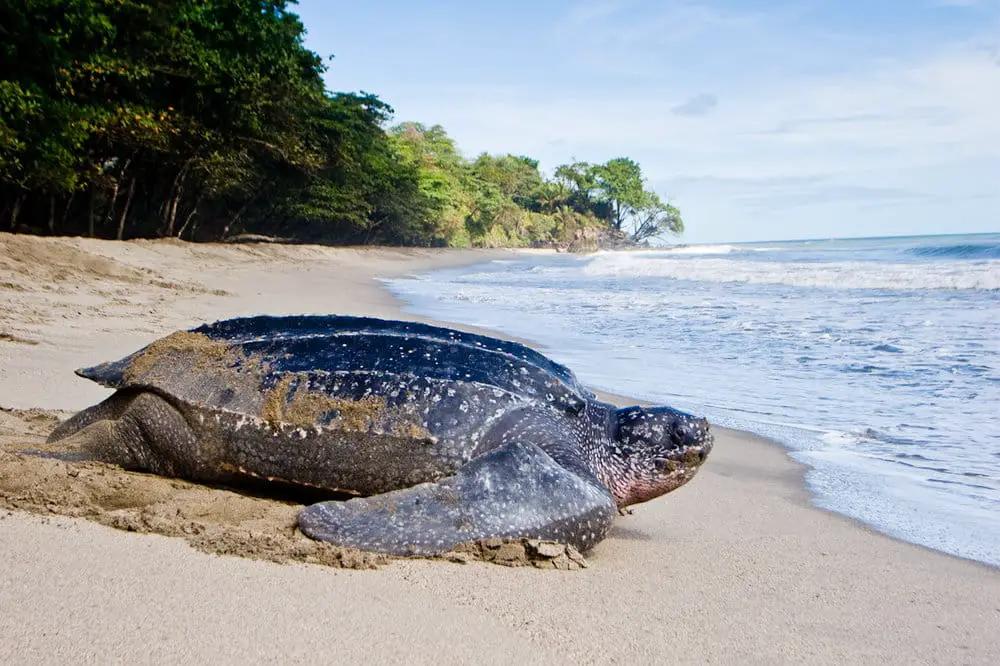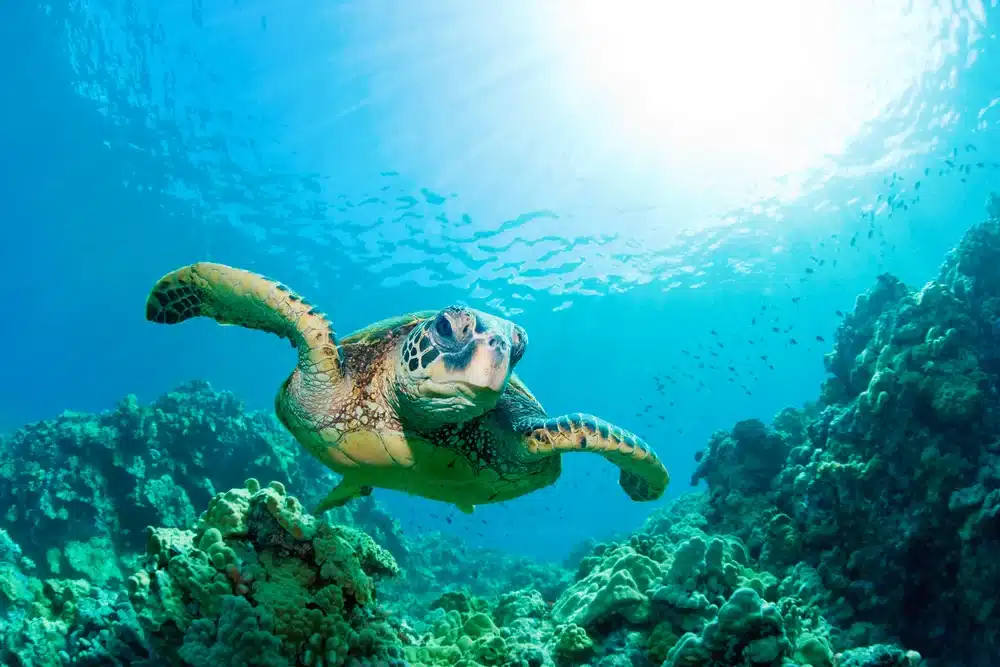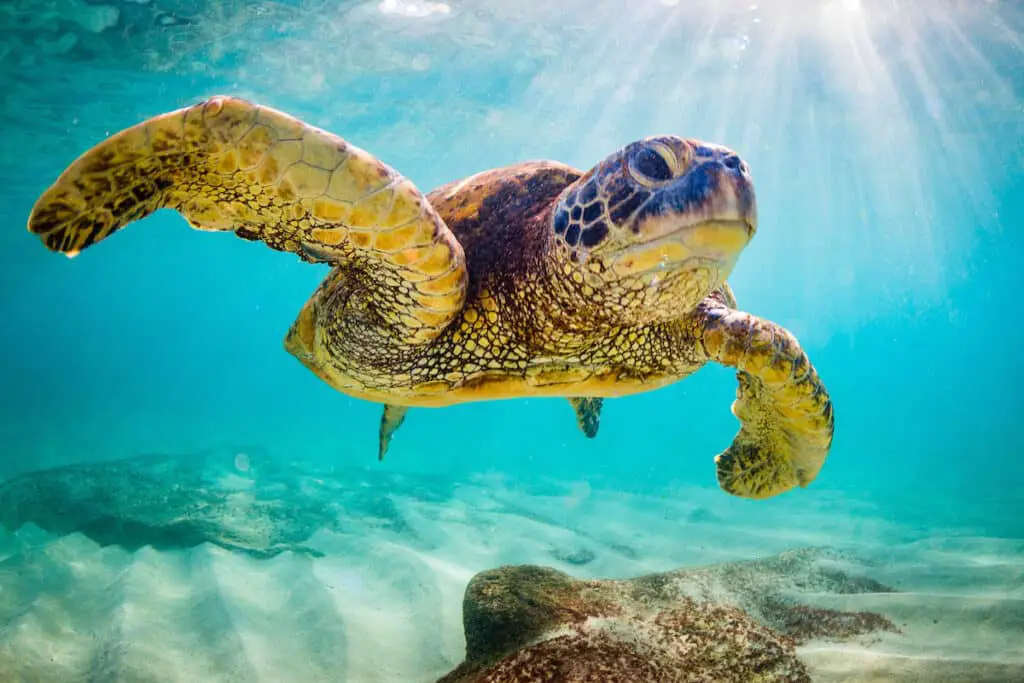How Deep Can Sea Turtles Dive

Introduction
How Deep Can Sea Turtles Dive: The depths of the ocean have always fascinated humanity, hiding mysteries and wonders that continue to captivate our imagination. Among the many remarkable creatures that call the ocean home, sea turtles stand out as both graceful and enigmatic. These ancient mariners are known for their long migrations across the seas, but what truly intrigues researchers and ocean enthusiasts alike is their ability to dive to astonishing depths.
We delve into the fascinating world of these aquatic reptiles and uncover the secrets of their underwater journeys. Sea turtles are renowned for their exceptional adaptations to aquatic life, and their diving abilities are a testament to their remarkable physiology.
We will journey alongside these majestic creatures as we unravel the science behind their deep-sea adventures. What drives them to explore such depths, and how do they withstand the immense pressure of the ocean’s abyss? We will also investigate the ecological significance of their deep dives, shedding light on the vital role sea turtles play in marine ecosystems.
Join us as we embark on a voyage to discover the incredible depths sea turtles can reach and gain a deeper appreciation for the intricacies of life beneath the ocean’s surface. This journey promises to unveil the mysteries of the deep and offer a glimpse into the awe-inspiring world of sea turtles.

Can sea turtles dive?
Most turtles can dive to depths of up to 290 m (960 ft). However, one species of sea turtle—the leatherback—can dive over 1,000 m (3,000 ft)! The maximum depth ever recorded for a sea turtle dive was a leatherback that dove 1,200 m (3937 ft).
Sea turtles are renowned for their remarkable diving abilities. These ancient reptiles have evolved over millions of years to thrive in the ocean’s depths. Depending on the species, sea turtles can dive to various depths, with some astonishing records on their resume.
The leatherback sea turtle, the largest of all sea turtle species, is known to reach the greatest depths, plunging as far as 4,000 feet (1,200 meters) below the surface. Even smaller species, like the loggerhead and green sea turtles, are no strangers to deep dives, routinely reaching depths of around 1,000 feet (300 meters) or more during their foraging expeditions.
What makes these dives even more incredible is that sea turtles can hold their breath for extended periods. Some individuals can remain submerged for up to five hours. These impressive capabilities are essential for their survival, as they enable sea turtles to access food sources such as jellyfish and sponges, which are found at considerable depths.
As we explore the depths to which sea turtles can dive, we gain insight into their unique adaptations and the critical role they play in maintaining the health of marine ecosystems.
How long can sea turtles stay underwater?
When they are active, sea turtles must swim to the ocean surface to breathe every few minutes. When they are resting, they can remain underwater for as long as 2 hours without breathing.
Sea turtles are renowned for their astonishing ability to hold their breath and stay underwater for extended periods. The duration of their dives can vary depending on factors such as species, age, and activity. While there is some variation, sea turtles, in general, are impressive breath-holders.
Some sea turtles, like the loggerhead and green sea turtles, can typically stay submerged for 4 to 5 minutes during routine activities such as foraging or swimming. However, when they are resting or sleeping, they can remain underwater for much longer, often exceeding 7 hours.
The leatherback sea turtle, the largest of all sea turtle species, boasts even more remarkable breath-holding capabilities. These giants can hold their breath for up to 85 minutes during vigorous activity, such as hunting for their primary prey, jellyfish. When they are resting or in a more relaxed state, leatherbacks can remain submerged for several hours.
These incredible adaptations enable sea turtles to explore various depths in the ocean while searching for food, evading predators, or even migrating across vast distances. Their ability to stay underwater for extended periods plays a crucial role in their survival and underscores their status as remarkable and highly specialized marine reptiles.
What is the deepest dive in a leatherback sea turtle?
4,000 Feet
Leatherbacks have been documented diving deeper than 4,000 feet (1,200 meters). By contrast, scuba divers typically descend to only about 100 feet (30 meters).
The leatherback sea turtle, the largest of all sea turtle species, is renowned for its remarkable deep-diving capabilities. These magnificent creatures are known to embark on incredible journeys into the ocean’s depths in search of their primary prey, jellyfish. While specific data on the deepest recorded dive of a leatherback sea turtle can vary, there have been documented dives exceeding depths of 4,000 feet (approximately 1,200 meters).
One of the most notable studies on leatherback sea turtle diving behavior involved an individual that was recorded diving to an astounding depth of around 3,900 feet (1,188 meters). This remarkable feat emphasizes the extraordinary adaptations of leatherbacks, including their ability to endure intense water pressure at such depths.
Leatherback sea turtles are equipped with unique physiological features, including a specialized circulatory system and a thick, leathery shell that provides some protection against pressure changes. These adaptations enable them to venture into the deep, dark realms of the ocean where they can access their preferred prey, jellyfish.
Why do turtles dive?
Routinely diving to depths of several hundred meters, leatherbacks are occasionally known to plunge as deep as 1250 meters. The animals probably plumb the depths to avoid predators, search for prey and avoid heat in the tropics.
Turtles, both freshwater and marine, engage in diving for various essential reasons deeply ingrained in their biology and survival strategies.
- Foraging: Turtles primarily dive in search of food. Marine turtles, for instance, explore the depths to find their prey, which often includes jellyfish, sea urchins, and various types of algae.
- Thermoregulation: Turtles are ectothermic, meaning their body temperature is influenced by their environment. Diving can be a way to regulate body temperature.
- Avoiding Predators: Diving is also an effective strategy for evading predators. Turtles can quickly submerge themselves to escape potential threats, using the water as a shield against land-based predators.
- Resting and Sleeping: Turtles occasionally dive to rest or even sleep underwater. During these periods of inactivity, they can remain submerged for extended durations.
- Mating and Nesting: Some turtle species perform elaborate underwater courtship rituals, with males diving and engaging in displays to attract females for mating. Additionally, certain sea turtles return to the shore to nest, and they may dive while approaching the nesting site.
Diving is a multi-purpose activity for turtles, serving purposes such as foraging, thermoregulation, predator avoidance, resting, and reproduction. These behaviors showcase the remarkable adaptability of turtles to their aquatic habitats.
What is the deepest dive for a turtle?
They are also accomplished divers with the deepest recorded dive reaching nearly 4,000 feet—deeper than most marine mammals. The leatherback turtle has the widest global distribution of any reptile, with nesting mainly on tropical or subtropical beaches.
The deepest dive recorded for a turtle is a remarkable feat of nature’s engineering. Leatherback sea turtles (Dermochelys coriacea) hold the record for the deepest recorded dive among all turtle species. These astonishing creatures have been known to plunge to depths of up to 4,200 feet (1,280 meters) or more. Such incredible depths take them into the abyssal zones of the ocean, where darkness and immense pressure challenge their survival.
Leatherback sea turtles have several unique adaptations that allow them to achieve these extraordinary dives. They possess a specialized physiology that includes a flexible shell, a high oil content in their bodies, and a heat-conserving circulatory system. These adaptations not only enable them to endure the crushing pressure but also to regulate their body temperature in the frigid depths.
Their deep-sea excursions are primarily driven by the search for their favorite prey, jellyfish. These remarkable creatures remind us of the astounding diversity and adaptability of life in the ocean, offering a glimpse into the mysteries of the deep and the awe-inspiring abilities of the natural world’s most ancient mariners.
Do all sea turtle species dive to the same depths?
Leatherback sea turtles, for instance, are renowned for their astonishing deep-diving abilities. They can plunge to depths exceeding 1,000 meters, a feat unmatched by any other marine reptile. This is made possible by their unique physiology, including a flexible shell and a specialized circulatory system.
Loggerhead and green sea turtles are considered more shallow divers. While they are proficient at navigating coastal waters and foraging in shallower areas, they typically do not venture into the abyssal depths frequented by leatherbacks. Instead, they exhibit a preference for environments characterized by seagrass beds and coral reefs.
Hawksbill sea turtles, with their narrower shells and more agile build, tend to inhabit coral reefs and rocky outcrops. Their diving behavior is primarily focused on these shallower, complex ecosystems.
Olive ridley sea turtles display a diverse range of diving behaviors, as they are found in both nearshore and offshore environments. Their dives can vary widely in depth, influenced by factors such as location and available food sources.
The depth to which sea turtles dive is intricately linked to their species-specific adaptations and the ecological niches they have evolved to occupy. Understanding these distinctions is vital for the conservation and protection of these magnificent creatures and their respective habitats.
How do sea turtles manage to stay submerged for so long?
Sea turtles possess a remarkable suite of adaptations that allow them to stay submerged for extended periods. Central to this ability is their capacity to regulate buoyancy. By adjusting the volume of air within their lungs and utilizing specialized anatomical structures known as cloacal bursae, sea turtles can fine-tune their buoyancy levels.
Sea turtles exhibit a remarkable ability to slow down their metabolic rates while submerged. This metabolic flexibility allows them to conserve oxygen and endure extended periods without needing to surface for air. They achieve this by redirecting blood flow away from non-essential functions, effectively slowing down their heart rate and reducing oxygen consumption.
Their circulatory system is uniquely adapted to the challenges of deep-sea diving. The high concentration of myoglobin in their muscles aids in oxygen storage, allowing them to function efficiently even in low-oxygen environments.
Behaviorally, sea turtles employ strategic diving patterns. They often alternate between periods of active swimming and passive drifting, conserving energy and oxygen during the latter. This balanced approach optimizes their time spent beneath the waves.
The extraordinary ability of sea turtles to remain submerged for extended durations is a result of a finely tuned interplay between physiological adaptations, metabolic regulation, and strategic behavioral patterns. These adaptations equip them to thrive in the challenging and dynamic underwater environments they call home.
Are there any dangers associated with deep diving for sea turtles?
While sea turtles are adept at deep diving, this behavior is not without its risks. One significant danger arises from the pressure changes experienced as they descend and ascend. The rapid shifts in pressure can lead to barotrauma, a condition characterized by physical damage to the turtle’s body tissues and organs. This can particularly affect their lungs and digestive system, potentially causing injuries or impairing their ability to regulate buoyancy.
Another peril faced by deep-diving sea turtles is the potential for encounters with human-induced hazards. Entanglement in fishing gear, such as nets and lines, poses a significant threat. Many turtles inadvertently become bycatch, leading to injuries or fatalities.
The increasing presence of anthropogenic pollutants in deep-sea environments is a growing concern. Contaminants like heavy metals and chemicals can accumulate in turtles’ tissues, potentially leading to long-term health issues.
Climate change-induced alterations in oceanic conditions also pose risks. Rising temperatures and ocean acidification can disrupt the delicate balance of marine ecosystems, impacting the availability of prey and suitable habitats for sea turtles.
While sea turtles have evolved remarkable adaptations for deep diving, they are not impervious to the hazards associated with these behaviors. Human activities and environmental changes pose significant challenges, underscoring the urgent need for conservation efforts to safeguard these ancient mariners and their vital marine habitats.

Conclusion
The remarkable abilities of sea turtles to dive to astonishing depths have fascinated researchers and marine enthusiasts alike. Through a combination of physiological adaptations and behavioral strategies, these ancient creatures have evolved to thrive in the depths of our oceans. The study of sea turtle diving behavior has not only provided insights into their ecology but has also shed light on the broader understanding of marine ecosystems.
It is clear that sea turtles are exceptionally well-adapted to a life beneath the waves. Their ability to regulate buoyancy, slow down metabolic rates, and tolerate high pressures showcases the incredible versatility of these creatures. Moreover, the variation in diving behavior across species highlights the nuanced ways in which different turtles have evolved to exploit their unique habitats.
However, it is crucial to acknowledge the increasing threats that sea turtles face in today’s rapidly changing environment. From plastic pollution to climate-induced alterations in oceanic conditions, these creatures confront numerous challenges. To ensure the continued survival of sea turtles and the preservation of their deep-sea habitats, concerted global efforts are required.
The study of sea turtle diving behaviors not only illuminates the remarkable adaptations of these creatures but also underscores the urgent need for conservation measures. As stewards of our planet, it is incumbent upon us to protect these ancient mariners and the delicate ecosystems they call home.



